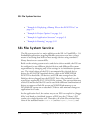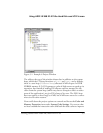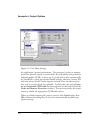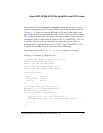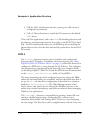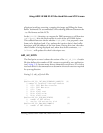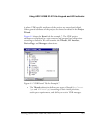
Example 6: Application Structure
5-10 Getting Started with ADSP-BF548 EZ-KIT Lite
3. Call the FSS’s initialization function, passing in a table of seven
configuration parameters
4. Call a C-library function to install the FSS instance as the default
STDIO driver
That is all! Our application’s calls to the STDIO file handling functions and
the directory manipulation functions now apply to the EZ-KIT Lite hard
disk. The FSS automatically takes care of initializing and controlling the
physical device driver (for the disk) and the file system driver (for the FAT
file system).
LCD.c
The InitLCD() function contains code to initialize and configure the
driver for the LCD display. In addition, the driver layering (see “Sharp
LQ043T1DG01 LCD Device Driver” on page 5-3) allows the function to
configure an EPPI driver, acting through the LCD driver. The configura-
tion parameters are commented in the source file. For complete details,
see the Sharp LQ043T1DG01 LCD and the EPPI drivers documentation
in the <install_path>\Blackfin\docs folder of VisualDSP++.
The most interesting part of the configuration process is how the DMA
chains for the frame buffers are initialized, and how the DMA data flow is
set up. In
LCD.c, the data flow configuration is described in a comment
headed DMA buffer preparation. The DMA Manager section of the
Device Drivers and System Services Manual for Blackfin Processors in the
online help contains introductory and reference material about managing
DMA in your applications.
The DisplayBMP() function is responsible for opening a named file con-
taining a suitable bitmap image, reading the file’s contents into a
temporary frame buffer, and causing the LCD driver to start displaying
the new image. The function’s code is straightforward, with the only com-



